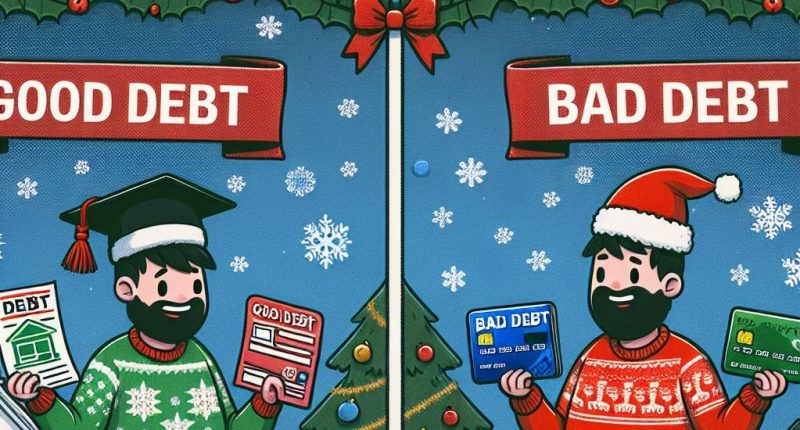- Understanding and managing debt effectively can help you start the year on a strong financial footing
- Not all debt is created equal, and knowing the difference between good and bad debt can guide your financial decisions
- By implementing effective debt management strategies, you can take control of your finances
- The key to successful debt management is consistency and discipline
The holiday season is a time of celebration, and often, significant spending.
From gifts and travel to festive meals and decorations, the expenses can quickly add up. As we step into the new year, the reality of holiday spending sets in, and it’s crucial to address any debt accumulated during this period. Understanding and managing debt effectively can help you start the year on a strong financial footing.
Good debt vs. bad debt
Before diving into debt management strategies, it’s essential to distinguish between good debt and bad debt. Not all debt is created equal, and understanding the difference can guide your financial decisions.
Good debt:
- Investment in your future: Good debt typically includes loans that help you acquire assets or improve your financial situation in the long run. Examples include student loans, mortgages, and business loans. These types of debt can lead to increased earning potential, home ownership, or business growth.
- Lower interest rates: Good debt often comes with lower interest rates, making it more manageable and less costly over time.
Bad debt:
- Consumer debt: Bad debt usually refers to borrowing for items that do not appreciate in value or generate income. Credit card debt, payday loans, and car loans often fall into this category.
- High interest rates: Bad debt typically carries higher interest rates, which can quickly escalate and become unmanageable if not addressed promptly.
Debt management strategies
- Create a Budget:
- Track your spending: Start by tracking your expenses to understand where your money is going. This will help you identify areas where you can cut back.
- Set financial goals: Establish clear financial goals, such as paying off a specific amount of debt each month. A budget can help you allocate funds towards these goals.
- Prioritize debt repayment:
- Avalanche method: Focus on paying off debts with the highest interest rates first while making minimum payments on others. This method can save you money on interest in the long run.
- Snowball method: Start by paying off the smallest debts first to build momentum and motivation. Once a debt is paid off, move on to the next smallest.
- Consolidate debt:
- Debt consolidation loans: Consider taking out a debt consolidation loan to combine multiple debts into a single payment with a lower interest rate.
- Balance transfer credit cards: Transfer high-interest credit card debt to a card with a lower interest rate or a 0% introductory rate.
- Negotiate with creditors:
- Lower interest rates: Contact your creditors to negotiate lower interest rates or more favorable repayment terms.
- Debt settlement: In some cases, creditors may be willing to settle for a lump-sum payment that is less than the total amount owed.
- Seek professional help:
- Credit counseling: Non-profit credit counseling agencies can provide guidance and help you create a debt management plan.
- Debt management plans (DMPs): A DMP involves working with a credit counselor to negotiate lower interest rates and consolidate payments.
- Build an emergency fund:
- Save regularly: Set aside a portion of your income each month to build an emergency fund. This can prevent you from relying on credit cards or loans in case of unexpected expenses.
- Avoid accumulating more debt:
- Limit credit card use: Use credit cards only for essential purchases and pay off the balance in full each month.
- Live within your means: Adjust your lifestyle to match your income and avoid unnecessary expenses.
By understanding the difference between good and bad debt and implementing effective debt management strategies, you can take control of your finances and start the new year on a positive note. Remember, the key to successful debt management is consistency and discipline. With a clear plan and commitment, you can reduce your debt and achieve financial stability.
The material provided in this article is for information only and should not be treated as investment advice. For full disclaimer information, please click here.
(Top image generated with AI.)





